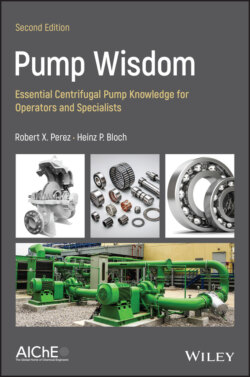Читать книгу Pump Wisdom - Robert X. Perez - Страница 19
The Importance of Suction Specific Speed
ОглавлениеNote that pump suction specific speed (N ss or N sss) differs from the pump specific speed N s discussed earlier. For installations delivering over 2500 gpm and with suction specific speeds over 9000, greater care is needed. Suction specific speed (N sss or N ss) is calculated by the straightforward mathematical expression:
wherein both the flow rate and NPSHr pertain to conditions published by the manufacturer. In each case, these conditions (flow in gpm) and NPSHr are observed on the maximum available impeller diameter for that particular pump.
The higher the design suction specific speed, the closer the point of suction recirculation to what is commonly described as rated capacity. Similarly, the closer the discharge recirculation capacity is to rated capacity, the higher the efficiency. Pump system designers are tempted to aim for highest possible efficiency and suction specific speed. However, such designs might result in systems with either limited pump operating range or, if operated inside the recirculation range, disappointing reliability and frequent failures.
Although more precise calculations are available, trend curves of probable NPSHr for minimum recirculation and zero cavitation‐erosion in water, Figure 1.11, are sufficiently accurate to warrant our attention [7]. The NPSHr needed for zero damage to impellers and other pump components may be many times that published in the manufacturer's literature. The manufacturers' NPSHr plot (lowermost curve in Figure 1.11) is based on observing a 3% drop in discharge head or pressure; at Q = 100%, we note NPSHr = 100% of the manufacturer's claim. Unfortunately, whenever this 3% fluctuation occurs, a measure of damage may already be in progress. Assume the true NPSH r is as shown in Figure 1.11 and aim to provide an NPSHa in excess of this true NPSHr .
In Ref. [7], Irving Taylor compiled his general observations and alerted us to this fact. He cautioned against considering his curves totally accurate and mentioned the demarcation line between low and high suction specific speeds somewhere between 8000 and 12 000. Many data points taken after 1980 point to 8500 or 9000 as numbers of concern. If pumps with N ss numbers higher than 9000 are being operated at flows much higher or lower than BEP, their life expectancy or repair‐free operating time will be reduced.
In the decades after Taylor's presentation, controlled testing has been done in many industrialized countries. The various findings have been reduced to relatively accurate calculations that were later published by HI, the Hydraulic Institute [8]. Relevant summaries can also be found in Ref. [9]. Calculations based on Refs. [8, 9] determine minimum allowable flow as a percentage of BEP.
Figure 1.11 Pump manufacturers usually plot only the NPSHr trend associated with the lowermost curve. At that time a head drop or pressure fluctuation of 3% exists and cavitation damage is often experienced.
Source: Taylor [7].
Note, again, that recirculation differs from cavitation, a term which essentially describes vapor bubbles that collapse. Cavitation damage is often caused by low net positive suction head available (NPSHa). Such cavitation‐related damage starts on the low‐pressure side and proceeds to the high‐pressure side. An impeller requires a certain net positive suction head; this NPSHr is simply the pressure needed at the impeller inlet (or eye) for relatively vapor‐free flow.
